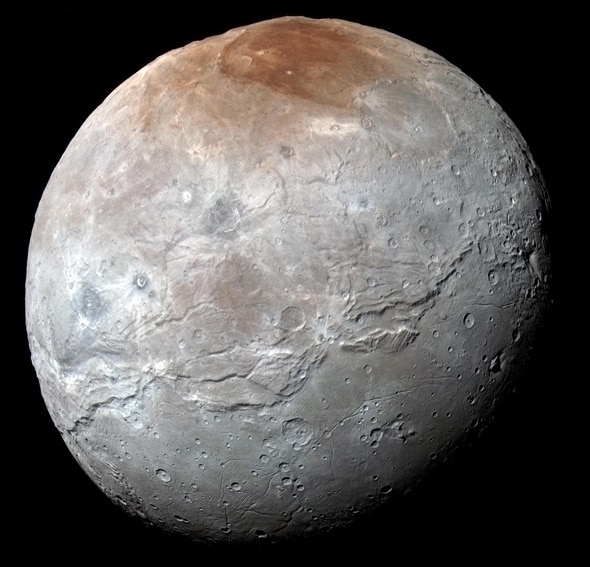Create a free profile to get unlimited access to exclusive videos, sweepstakes, and more!
Behold, the Mess That Is Charon

Charon is so, so weird.
It’s also astonishingly beautiful. Look at it! The image above is a newly released high-resolution color photo of Pluto’s largest moon, taken by the New Horizons spacecraft when it zipped past the Pluto system in July 2015. It’s been enhanced to bring out the color variations more, but this also gives us an idea about the surface features, and how they vary across this strange little world.
There’s so much to see! The most obvious bit is the red splotch at the north pole, informally named Mordor Macula (macula means spot and is commonly used in planetary nomenclature to refer to a big dark region; Mordor is a place you simply don’t walk into).* Pluto is covered in red spots, and it’s thought these are tholins, carbon-based molecules created when ultraviolet sunlight breaks apart molecules, which then reorganize themselves into more complex structures.
Very little of the rest of Charon is red, prompting some scientists to conjecture that Mordor Macula is from some sort of transfer of material from Pluto onto Charon’s surface, possibly from Pluto’s extremely tenuous (but observable) atmosphere. Craters in Mordor are bright, indicating the red material is a veneer; thin enough that small impacts excavate brighter material (likely ices) underneath.
The next most obvious feature is that huge canyon separating the north and south hemispheres. The canyon is staggeringly huge, at least 1,600 kilometers long, making it four times longer than the Grand Canyon and in places far deeper. To scale with Charon, it’s similar to Valles Marineris, the vast canyon scarring the face of Mars.
By the way, the stretch of the canyon just to the right of center, to the right of that centered crater? That’s called Serenity Chasma, and it’s named that way for exactly the reason you think. Shiny.
There’s a big dichotomy between the hemispheres, too. The southern half of Charon has a smoother look—this area is dubbed Vulcan Planum, the Plains of Vulcan—dotted with craters and what looks like cracks or graben (downward thrusted rocks, usually due to faulting as the crust expands). The northern half looks more rugged, less smooth. Perhaps some ancient event caused cryovolcanism—ice volcanoes!—in the southern hemisphere, flooding the plains with ice.
We only have good images of this side of Charon, unfortunately, because the New Horizons mission was a very fast flyby. I’d love to know what the other side looks like in this sort of detail!
A high-res mosaic of part of Charon was also released. It’s well worth your time to peruse the whole thing, but there’s one spot I want to point out:
See that linear feature just above center? That’s a crater chain, usually caused when debris from a big impact is ejected, and then falls back to the ground. But this one is a bit weird; the craters are very close together, almost overlapping, and they don’t seem to point to any other obvious big crater. I’m wondering if this is due to a small body breaking up before it hit, forming a long chain of objects that then hit one after the other along a line. This happened when the comet Shoemaker-Levy 9 hit Jupiter in 1994; Jupiter’s immense gravity ripped the comet into pieces, which hit one after another over several days. Neither Pluto nor Charon has strong gravity, so I’ll admit this seems unlikely. It’s an intriguing formation either way.
As I mentioned, the picture of Charon is enhanced in color to show surface variations. Here’s one more picture, showing what it actually looks like in comparison with Pluto, with both bodies scaled the same way.
Charon is a lot darker than Pluto! That in itself is interesting. Charon most likely formed when an impact on Pluto blew some or most of its crust into space, which went into orbit and coalesced to form Charon (and perhaps the smaller moons, too). It seems to me that they may have started off looking similar, but subsequent events changed them, either brightening Pluto or darkening Charon, or both. Both show evidence of cryovolcanism or more recent resurfacing (the left side of Pluto’s “heart” is likely to be nitrogen ice that’s glacially flowed into lower elevations).
As more images and data trickle back from New Horizons, traveling the long, long emptiness stretching for five billion kilometers, we’ll learn more about the surfaces of these worlds. But every new picture shows something weird and wonderful, and while we get traction on some mysteries, others deepen.
Oh, how I love that! Science is fun.
*Features on Charon are informally named at the moment, but the agreed-upon nomenclature is that they are named after fictional destinations, ships, or voyagers.


























